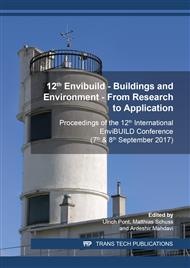[1]
European Commission. Directive 2010/31/EU of the European Parliament and of the council of 19th May 2010 on the energy performance of buildings (recast). Official Journal of European Union 153 (2010) 13 – 35.
Google Scholar
[2]
E. Carlon, M. Schwarz, A. Prada, L. Golicza, V. K. Verma, M. Baratieri, W. Haslinger, and C. Schmidl, On-site monitoring and dynamic simulation of a low energy house heated by a pellet boiler. Energy and Buildings 116 (2016) p.296–306.
DOI: 10.1016/j.enbuild.2016.01.001
Google Scholar
[3]
A.T. Nguyen, S. Reiter, P. Rigo, A review on simulation-based optimization methods applied to building performance analysis, Applied Energy 113 (2014) pp.1043-1058.
DOI: 10.1016/j.apenergy.2013.08.061
Google Scholar
[4]
K. Deb, A. Pratap, S. Agarwal, T.A.M.T. Meyarivan, A fast and elitist multiobjective genetic algorithm: nSGA-II, IEEE Transaction on Evolutionary Computation 6 (2002) p.182–197.
DOI: 10.1109/4235.996017
Google Scholar
[5]
E. Zitzler and L. Thiele, Multiobjective evolutionary algorithms: A comparative case study and the strength Pareto approach. IEEE Transactions on evolutionary computation 3 (1999) p.257–271.
DOI: 10.1109/4235.797969
Google Scholar
[6]
K. Deb and H. Jain, An evolutionary many-objective optimization algorithm using reference-point based non-dominated sorting approach, part I: Solving problems with box constraints. IEEE Transactions on Evolutionary Computation, 18 (2014) p.577–601.
DOI: 10.1109/tevc.2013.2281535
Google Scholar
[7]
K. Deb and H. Jain, An evolutionary many-objective optimization algorithm using reference-point based non-dominated sorting approach part II: Handling constraints and extending to an adaptive approach. IEEE Transactions on Evolutionary Computation, 18 (2014) p.602–622.
DOI: 10.1109/tevc.2013.2281534
Google Scholar
[8]
Q. Zhang and H. Li, MOEA-D: A multi-objective evolutionary algorithm based on decomposition, IEEE Transactions on Evolutionary Computation, 11 (2007) p.712–731.
DOI: 10.1109/tevc.2007.892759
Google Scholar
[9]
P. Penna, A. Prada, F. Cappelletti, and A. Gasparella. Multi-objectives optimization of energy efficiency measures in existing buildings. Energy and Buildings 95 (2015) p.57–69.
DOI: 10.1016/j.enbuild.2014.11.003
Google Scholar
[10]
ASHRAE 90.1 Energy standard for buildings except low rise residential buildings. Technical report, ASHRAE - American Society of Heating, Refrigerating, and Air-Conditioning Engineers, Atlanta, Georgia (2007).
DOI: 10.2172/5737921
Google Scholar
[11]
Haller MY, Paavilainen J, Konersmann L, Haberl R, Dröscher A, Frank E, et al. A unified model for the simulation of oil, gas and biomass space heating boilers for energy estimating purposes. Part I: model development. Journal of Building Performance Simulation 4 (2011) p.1–18.
DOI: 10.1080/19401491003671944
Google Scholar
[12]
M.Y. Haller, J. Paavilainen, L. Konersmann, R. Haberl, A. Dröscher, E. Frank, C. Bales, W. Streicher, A unified model for the simulation of oil, gas and biomass space heating boilers for energy estimating purposes Part II: parameterization and comparison with measurements, Journal of Building Performance Simulation 4 (2011) p.19–36.
DOI: 10.1080/19401491003653629
Google Scholar
[13]
UNI/TS 11300-1, Energy performance of buildings – Part 1: Evaluation of energy need for space heating and cooling, UNI, (2008).
Google Scholar
[14]
European Commission, Commission Delegated Regulation (EU) No 244/2012 of 16 January 2012 supplementing Directive 2010/31/EU, (2012).
Google Scholar
[15]
EN 15459, Energy performance of buildings – Economic evaluation procedure for energy systems in buildings. CEN (2009).
DOI: 10.3403/30344395
Google Scholar


